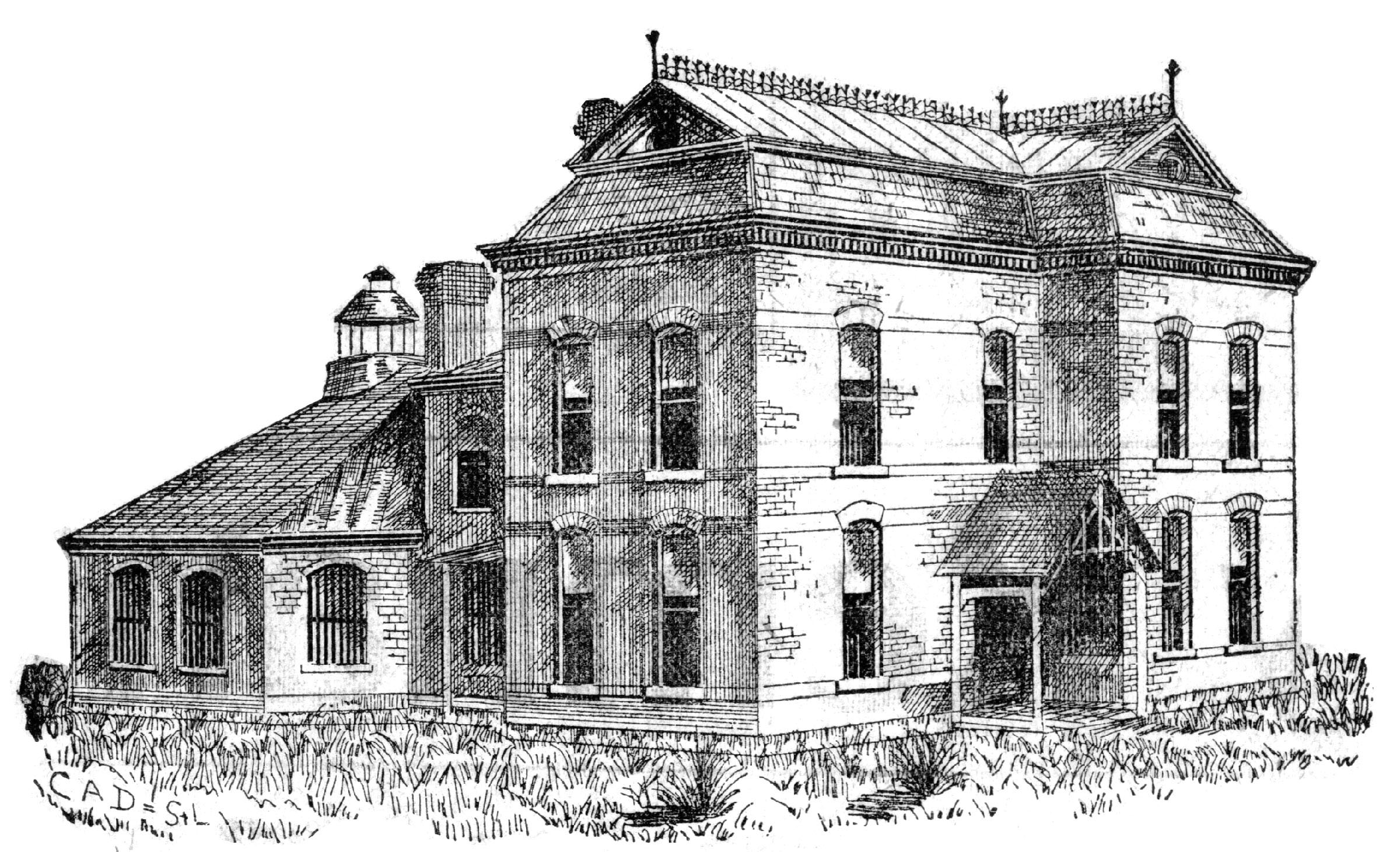Daviess County no longer has a jail which will accept prisoners. County Sheriff Harold Appley condemned the jail as of Nov. 1, 1975, as being unfit to receive prisoners.

Originally designed to operate 8 jail cells rotating behind the stationary bars of the “squirrel cage,” the jail was changed to be two large holding areas. A solid metal wall bisected the building; squirrel cage bars were configured to provide two holding cells (right). Metal panels lined walls and ceiling with concrete poured for floors and to secure toiletries. Window openings were downsized, with metal grating welded over the openings for security. (date unknown)
In a letter to Presiding Judge Robert Owings, the sheriff stated: “Due to the present condition of the Daviess County Jail, which does not, in my opinion, meet any of the suggested minimum standards of county, state or federal jail committees as to health and sanitation, ventilation, lighting, prisoner safety, visiting facilities and the impossibility of a continual supervision of the prisoners, I feel it my duty, not only for my own personal liability but that of any prisoners, to condemn this jail as of November 1, 1975, until such time as reasonable quarters can be provided for incarceration of suspected, apprehended or convicted violators of the law.”
The sheriff previously said that he is the only official authorized to condemn a jail. He said Circuit Judge Kenneth Lewis had refused to place prisoners in the Daviess County Jail for many months.

(Date Unknown) — The original bars securing jail windows were replaced by the metal grates shown here. It is thought that the original bars were horizontal and offset, allowing prisoners to tilt or open a glass window frame pivoted between the bars.
“I have asked for improvements to be made in the jail from time to time,” Appley said, “but the court says they are broke and lake the funds. I do not question that they are hard-pressed for money but this jail is no longer suitable for anyone to be housed in it.”
Appley said it would probably be cheaper for the court to house prisoners in another jail in the long run since the costs of maintaining and heating the old jail and living quarters are so expensive.

A locker, to hold prisoners’ personal items during incarcerations, was to the left of the heavy metal swinging door entrance into the jail. A combination lock secured the locker. The singular doorway was also the jail’s only exit, thus contributing to the state’s condemnation of the facility’s use.
Following a meeting of the county court and the sheriff, Judge Owings said it appeared the court has but two alternatives. The first is to make repairs and changes to the present jail to meet the standards; second, to consider moving the jail into new facilities on the upper floor of the courthouse.
The court made an inspection of the fourth floor to determine if this alternative would be feasible. Owings said that the improvements submitted by Sheriff Appley for the old jail were “not bad” as far as expense was concerned but the feeling persists that the old jail facility has simply outlived its time and ought to be replaced.
Judge Owings said the county needs a new jail and he would have liked to see one built “but things just haven’t worked out.” He indicated county prisoners would now be sent to nearby jails until a solution for this county can be reached.
The Daviess County Jail has had an interesting history since it was built in 1888. Until some years ago it contained what was commonly called the “squirrel cage” cells which could be spun around like a merry-go-round with one common entrance to all cells. This apparatus was removed in a major remodeling project some years ago but living conditions inside the jail were not helped much. Sanitation, light and heat have remained a serious deficiency.

Sheriff’s residence and Rotary Jail during term of Sheriff Houghton
Living conditions for the sheriff and his family have also been poor in recent years. These quarters are near the cell area and meals for the prisoners were prepared in the sheriff’s kitchen. Just a few days ago, Sheriff and Mrs. Appley were eating lunch when a snake fell out of the ceiling.
“With the condition of the jail what it is,” Appley said, “there isn’t any way to keep the place in good order.”
— reprinted from the Gallatin North Missourian, Nov. 6, 1975

Blueprints of the plans to renovate the Squirrel Cage Jail were drafted by inmates who performed the reconstruction while incarcerated at Western Missouri Correctional Center at Cameron. The static display of the squirrel cage was disassembled, then transported to Gallatin to be reassembled inside the authentic jail building.

A new roof was top priority during renovations in 1991. Ornate metal roof decorations were previously removed. The front porch on the sheriff’s residence required little repair. Sandstone window sills were generally in poor shape but no changeouts were attempted.

Decay of the jail’s brick exterior was accelerated when an interior metal lining was added while modifying the original squirrel cage area to two large cells. The metal held moisture against the brick for many years, causing the mortar to rot. Thus, during reclamation in 1991, the jail’s exterior brick had to be entirely replaced.

The 1889 Squirrel Cage Jail as it appeared in 1995. Available funds did not allow for recreating the original jail bars on the octagon-shaped jail. Those donating to the reclamation project were noted on engraved bricks in a sidewalk surrounding the jail.

